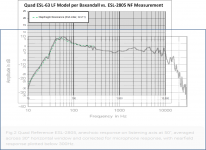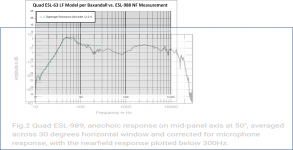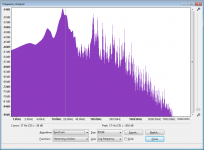It sounds like you are describing planar magnetics.
Actually, yes. (Off topic, I was hoping that WrineX would comment on this).
Those have low resistance metallic layers that are often patterned to maintain the proper induced field orientation. It is basically a flattened voice coil operating in a permanent magnetic field. The mass of the coil is significant in these designs.
In electrostatic speakers, a very high resistance coating is typically applied uniformly to the diaphragm. The mass of the conductive layer on the diaphragm is low enough to be insignificant in most cases. As the name implies, electrostatic fields are used to move the diaphragm in this type of speaker.
Thank you. Both these techniques are excellent.
Can you share exactly what songs cause you problems? I would be interested to see what the frequency content of the song is. Most likely the issue you are experiencing is just running out of excursion capability at low frequencies. With your resonance at 18Hz, even if you completely damped it down to Q=0.7 you could still easily run into excursion problems in the 20-40Hz range. Adding a HP filter as you did is the most practical way to solve the issue. I’m not sure if you have Excel, but if you do you can use the ESL line source calculator to get a feel for what diaphragm excursion to expect at lower frequencies for a given input voltage. (assuming no limiting due to transformer saturation) You can also get a feel for how dramatically excursion increases as you go lower in frequency. Link = experiences with ESL directivity?…But +12dB @18 Hz is still problematic with some recordings (only a very few, but still I don't like the fact that I can't play all music without problems).
Regarding resonance damping in the Quad ESL:
It was mentioned, damping is provided by mesh glued to the rear stator. One thing to note, is that when you glue mesh to a perforated sheet, the acoustic resistance increases inversely to the open area. So if a perforated sheet stator is 40% open, a mesh with 40 Rayl acoustic resistance would behave like 100Rayl when glued to the stator. Unfortunately, this does not translate to wires, because their round cross-section results in ~100% open area at the contact point with the mesh.
As MarcelvdG already pointed out, Quad chose to damp their resonance to roughly a Q=2 so as to gain efficiency by EQing part of the LF response roll off. I had posted some plots and comparisons with ESL-63 measurements in the Walker AES paper here: Full Range Electrostatic Question
Overlaying the Q=2.1 curve from that post with the Stereophile NF<300Hz measurements of the ESL-988 and ESL-2805 look to be a pretty good match, although the 988 data appears to have some contamination from room reflections in the 200Hz range. I agree with stokessd, not much seems to have changed since the ESL-63.
Attachments
Hi Bolsterst,
agian - thanks for sharing your knowledge! The song that causes resonance problems is from the album:
"Ibn Battuta, The Traveller of Islam" by Jordi Savall. One of the tracks that causes problems is "Kouroukanfouga". Just after about 15 seconds the diaphragm starts resonating...
agian - thanks for sharing your knowledge! The song that causes resonance problems is from the album:
"Ibn Battuta, The Traveller of Islam" by Jordi Savall. One of the tracks that causes problems is "Kouroukanfouga". Just after about 15 seconds the diaphragm starts resonating...
Thanks! downloaded a copy of the track from youtube to analzye and think I see what the issue is. There is a huge peak in the LF noise centered very close to your 18Hz resonance, which would really excite the diaphragm to large excursion. The recording does include a lot of LF hall noise, but the LF peak causing the problem only starts just past 15seconds. Applying a 50Hz LP filter to the whole track, it appears content at that frequency peak is present for the remainder of the track. I checked a half dozen other tracks from the album and none of them had a similar peak. I'm not really sure what the source is. You can see the musical content is pretty much all > 90Hz. Attached is a spectrum of the first 30 seconds of the track. Also attached are some *.mp3 files of the first 30 seconds. One original, one LP filtered at 50 Hz so you can listen to just the LF noise, and one HP filtered at 35Hz so you can listen without the noise peak.
I recall a similar issue on a Sennheiser CD of the Colorado Symphony Orchestra. Several tracks had a ridiculous amount of 13Hz energy from the halls ventilation system. With my servo controlled subs, they flapped about wildly, but no really sound to hear. On lesser subs, the 2nd and 3rd harmonic distortion products resulted in a constant mind numbing drone during large portions of some tracks. The noise on your track sounds different than this did, so not sure if it is related to the hall ventilation system or not.
Exclusive Neumann & Sennheiser CD | hifiplusstore
I recall a similar issue on a Sennheiser CD of the Colorado Symphony Orchestra. Several tracks had a ridiculous amount of 13Hz energy from the halls ventilation system. With my servo controlled subs, they flapped about wildly, but no really sound to hear. On lesser subs, the 2nd and 3rd harmonic distortion products resulted in a constant mind numbing drone during large portions of some tracks. The noise on your track sounds different than this did, so not sure if it is related to the hall ventilation system or not.
Exclusive Neumann & Sennheiser CD | hifiplusstore
Attachments
Last edited:
You’re welcome - and again - thanks for unveiling these ‘hidden’ low frequency content!
Never realized that Hall effects and fans could exist in recordings - but it makes sense. So after all, it seems bad mixing as I guess these low frequencies don’t belong to the music itself. As it seems the diaphragm resonance frequency of my stats has only been sinking, currently at 18 Hz, this problem is just a minor one as most music I play has no or little energy in this region.
If I’m correct you used audacity for the frequency analysis?
Thanks for your directions to the spreadsheet, I will try it soon.
I already own a DSP - so it will be very easy to just apply a high-pass filter to filter the problematic lf region. But although these stat panels are rather big I am wondering, influenced by the impressive work by Jazzman, if it would make sense to implement a subwoofer as an addition to my latest panels? When looking to the frequency graph of my newest panels it seems they go rather low (30 Hz at listening position), but recent measurements, which I will publish soon, show that all transformers saturate when applying enough voltage. I have to test if they all saturate when playing music rather than sending 10 Hz test signals. But I could imagine that a ripole subwoofer has an easier job than my stats at sub bass frequencies? I'm curious if a well implemented subwoofer could be a positive addition to these panels. So would it make sense to add a subwoofer to these rather big panels? And do their relatively big panel size still make sense when considering to add subwoofers? I would think this is the case as bigger panels allow for lower cross-over frequency.
A lot of new questions…
Never realized that Hall effects and fans could exist in recordings - but it makes sense. So after all, it seems bad mixing as I guess these low frequencies don’t belong to the music itself. As it seems the diaphragm resonance frequency of my stats has only been sinking, currently at 18 Hz, this problem is just a minor one as most music I play has no or little energy in this region.
If I’m correct you used audacity for the frequency analysis?
Thanks for your directions to the spreadsheet, I will try it soon.
I already own a DSP - so it will be very easy to just apply a high-pass filter to filter the problematic lf region. But although these stat panels are rather big I am wondering, influenced by the impressive work by Jazzman, if it would make sense to implement a subwoofer as an addition to my latest panels? When looking to the frequency graph of my newest panels it seems they go rather low (30 Hz at listening position), but recent measurements, which I will publish soon, show that all transformers saturate when applying enough voltage. I have to test if they all saturate when playing music rather than sending 10 Hz test signals. But I could imagine that a ripole subwoofer has an easier job than my stats at sub bass frequencies? I'm curious if a well implemented subwoofer could be a positive addition to these panels. So would it make sense to add a subwoofer to these rather big panels? And do their relatively big panel size still make sense when considering to add subwoofers? I would think this is the case as bigger panels allow for lower cross-over frequency.
A lot of new questions…
Last edited:
Yes, Audacity was used both for the frequency analysis and LP/HP filtering of the audio clips. It is a handy piece of software if you are away from your measurement computer.
As you have found, it is very difficult to tame the diaphragm resonance to provide proper output at low frequencies. With DSP crossovers easy to obtain today, adding subwoofers to ESLs to improve bass quality and quantity can often the best option. Yes, my experience has been that the lower you can cross to the woofers (while still avoiding diaphragm resonance problems) the better.
As you have found, it is very difficult to tame the diaphragm resonance to provide proper output at low frequencies. With DSP crossovers easy to obtain today, adding subwoofers to ESLs to improve bass quality and quantity can often the best option. Yes, my experience has been that the lower you can cross to the woofers (while still avoiding diaphragm resonance problems) the better.
- Status
- This old topic is closed. If you want to reopen this topic, contact a moderator using the "Report Post" button.


